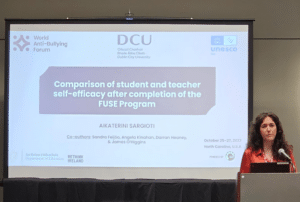Paranoia is the unfounded beliefs that others intend to cause physical and/or psychological harm. Emerging evidence reflects an association between bullying and paranoia in adolescence, but lacks control of theoretically relevant covariates (beliefs about paranoia, shame, social anxiety and emotional dysregulation). The aims of the present study
were to a) examine the association between bullying and paranoia b) compare severity of paranoia between clinical and non-clinical samples and c) establish the robustness of any association by controlling for the covariates. Data from questionnaires were obtained from clinical (N = 24) and non-clinical (N = 212) samples of 16 to 18 year old adolescents. Results indicated a strong association between bullying and paranoia. The severity of paranoia did not differ between clinical and non-clinical samples. Bullying appeared to contribute
independently with paranoia after controlling for the covariates in the non-clinical sample. Using the clinical sample, an indirect association was found between bullying and paranoia via emotional dysregulation and external shame. Findings are consistent with literature highlighting that bullying is associated with paranoia. Paranoia may serve an adaptive function to detect social threats, and therefore become heightened from bullying. Furthermore, this association appears to be influenced by emotional dysregulation and external shame. Future
research should further examine the association between bullying and paranoia, as well as other specific psychotic experiences such as hallucinations, in longitudinal large sample studies controlling for effects of theoretically relevance processes, including external shame and emotional regulation. Clarifying the roles of external shame and emotional dysregulation have important clinical implications in the context of bullying and paranoia experiences.
Search Results for “2024 Newest SHRM SHRM-SCP Test Vce Free 🩺 Go to website { www.pdfvce.com } open and search for ▷ SHRM-SCP ◁ to download for free 👓SHRM-SCP New Dumps Book”
Dr. Amalee Meehan has delivered a keynote address at a conference in Seville, Spain, on Religious Identity, Bullying, and Wellbeing at School.
Drawing on her research on religious identity and bullying in DCU Anti-Bullying Centre, Amalee presented a paper entitled “The Changing Place of Religion in Society”, during which she mapped the development of Ireland as a monotheistic society to one where those who continue to practice religion are often the targets of bullying in schools.
Dr. Meehan highlighted how many aspects of popular culture reinforce individualism and aggression, whereas the core message of most major world religions can be used as a basis to tackle bullying and promote belonging in schools.
The conference was organised at the University of Seville as part of the Cooperation in Science and Technology (COST) Action “ORBIT”, a transnational network focused on exploring the intersection between religious identity, bullying, and wellbeing in schools.
This thesis investigates workplace bullying which refers to repeated negative acts between two parties where power imbalance exists, normally the victim being the one with less power. The aim of this thesis is to (1) investigate the longitudinal impact of workplace bullying on employees’ health and well-being, (2) examine the cognitive reactions (PC) and behavioural reactions (coping strategies) as a mechanism of frontline employees in dealing with workplace bullying and (3) explore how employees perceive and make meaning of their bullying experiences in the workplace. This research uses a sequential explanatory mixed-method approach to identify and explore workplace bullying trough frontline employees’ perception. Study 1 examined 70 frontline employees from various organizations living in Kuala Lumpur, Malaysia. This study focuses on the longitudinal impact of workplace bullying on employees’ health and well-being and its reverse causation, mediating mechanism of perseverative cognition on the bullying-well-being relationship as well as the moderating role of coping in the mediating relationship through a survey approach. Meanwhile, Study 2 identified and explored actions that were perceived as bullying, experiences and reactions both cognitive and
behavioural of the victims dealing with workplace bullying, and the impacts on their health and well-being through a narrative approach. This study involved 20 participants recruited from Study 1 who were identified as victims. Results revealed that bullying was prevalent within the workplace which gives negative impact to the employees’ physical and psychological health. Repetitive negative thinking and worrying mediated the bullying-well-being relationship and this is moderated by certain acts of coping (e.g. problem solving and ignoring
the problem). Silent retaliation and religious coping were one of the themes that emerged from the second study. Results of the two studies will be discussed further in the following chapters. The findings from this thesis reveals the need to improve the awareness of workplace bullying phenomena and organization’s current practice that would fit the needs of front line employees. This includes providing greater organizational support, better reinforcements of current policies, improve communication and develop preventive interventions.
Few studies have focused on the perspectives of children with ‘learning difficulty’ labels in the UK. This exploratory study aimed to investigate the experience of children in a mainstream primary school in London who had been identified as having ‘learning difficulties’. Six children were observed in their school environment, interviewed using props and pictures, and invited to take photos of significant features of their daily lives. Data were transcribed and analysed thematically from a critical realist standpoint. The children in the study were mostly not remarkable from other children, either in their appearance or behaviour, or in their experiences and views. They had a variety of understandings and feelings about the additional support they received, but largely seemed fairly neutral about it and did not seem to feel particularly different from their peers. In contrast with much of the literature, stories of stigma and bullying were not found. This seemed to reflect an inclusive school culture. Some of the children were however noticeably socially isolated from their peers. Teaching assistants played a key role in several children’s lives, and this was largely positive, although their role sometimes constrained opportunities for peer interactions and autonomy. Although the sample was not representative of children with ‘learning difficulties’, the findings point to the possibility that schools can create an environment whereby children with different learning abilities or styles do not experience ‘impairment’ (difficulties with learning) or ‘disability’ (barriers to opportunities). This may only apply to children with milder differences from supportive families, but is consistent with theory that both impairment and disability are socially constructed. Further research is needed into how schools can create such an environment, as well as into barriers to friendships for children with ‘learning difficulty’ labels.
Introduction: Cyberbullying experiences have been linked to mental health difficulties, highlighting the need to refine anti-cyberbullying interventions, particularly for at-risk groups, and understand what encourages bystanders to intervene. The current study compared adolescents’ prosocial cyber-bystander intentions in an intragroup (‘UK-born’ victim status) and intergroup (‘immigrant’ victim status) cyberbullying context. State empathy and state self-efficacy were examined as potential mediators, accounting for baseline trait levels of these two factors and gender.
Methods: British adolescents (N=129; 13.5-15 years old; 59.7% female; predominately White) from two comprehensive schools in the UK took part in a two (gender: female/male) by two (victim status: British/immigrant) between-subjects quasi-experimental study. Participants were randomly assigned to read a gender-matched hypothetical cyberbullying vignette with an adolescent cyber-victim who was either ‘U.K.-born’ or an ‘immigrant’. Self-report questionnaires captured participants’ prosocial bystander intentions, state and trait self-efficacy and empathy, alongside demographic information.
Results: Findings showed that victim status did not relate to self-efficacy or prosocial cyber-bystander intentions. Higher empathy was reported by females and, unexpectedly, within the ‘immigrant victim’ condition. An indirect relationship was found between victim status and prosocial cyber-bystander intentions, with state empathy as a statistical mediator. Trait empathy did not moderate the path between victim status and state empathy.
Conclusions: The present study supports promoting bystander state empathy in anti-cyberbullying programmes, but the importance of intergroup processes is unclear. To reduce cyberbullying impact, future research should explore cyber-bystander behaviour towards at-risk groups inter-sectionally, controlling for additional intergroup variables which potentially caused a suppressor effect in the results.
This Research Project critically appraises the current dispute resolution mechanisms for employment law in Ireland. This exploration provides the basis for submissions to improve the overall service for workers, employers and Government. The researcher undertook the following strands of analysis: A comprehensive study and critical analysis of existing employment dispute resolution fora in Ireland both on a systematic level, and on a forum-specific level.
Aims: The overarching aim of this thesis was to evaluate the implementation of the MindOut social and emotional learning (SEL) programme with disadvantaged post-primary school students (15-18 years old) in Ireland. This study was conducted in three phases, each of which have been published. Phase 1 aimed to evaluate the immediate impact of the MindOut programme on students’ social emotional skills, mental health and wellbeing and academic outcomes. Phase 2 aimed to examine variability in implementation quality and to identify factors that contributed to this variability. Phase 3 aimed to determine how implementation quality impacted on programme outcomes.
Methods: The study employed a cluster-randomised controlled design with mixed methods approaches. A total of 675 students from 32 disadvantaged schools participated at baseline and data were collected from students and teachers before, during and following programme delivery. Phase 1 employed linear mixed models (LMM) to evaluate the effectiveness of the programme on students’ outcomes. Phase 2 used process measures to determine schools’ level of implementation quality across four implementation dimensions, and to identify factors that contributed to implementation quality. Phase 3 employed LMM’s to assess the relationships between the implementation data and outcome data across three time-points and between three treatment groups (high-implementation, low-implementation and control).
Results: Phase 1 demonstrated significant improvements in students’ social and emotional skills: reduced suppression of emotions (p=0.035), use of more positive coping strategies [reduced avoidance coping p=<0.001) and increased social support coping p=0.044)] and mental health and wellbeing: reduced levels of stress (p=0.017) and depressive symptoms (p=0.030) and reduced anxiety scores for female students (p=0.044). Phase 2 detected variability in implementation quality between schools and assigned eight schools to both the high- and low-implementation groups. Influencing factors were categorised into five themes: Programme Factors, Participant Factors, Teacher Factors, School Contextual Factors and Organisational Capacity Factors. Phase 3 revealed significant positive programme effects at post-intervention for the high-implementation group only (reduced suppression of emotions [p=.049]; reduced avoidance coping [p=.006]; increased social support coping [p=.009]; reduced levels of stress [p = .035] and depressive symptoms [p = .025]. At 12-month follow-up, reduced avoidance coping [p=.033] was the only sustained outcome.
Conclusions: Overall, these findings demonstrate that the MindOut programme can be effective in producing positive outcomes for participants, particularly those students of disadvantaged status. However, these positive outcomes were only evident in schools that implemented the programme with high-quality, signifying the importance of implementation quality in the overall success of a programme. The findings from this study have clear implications for policy, practice and future research and highlight a number of important factors to enhance implementation quality and strengthen programme outcomes.
A team from ABC was recently delighted to attend the World Anti-Bullying Forum 2023 in Raleigh, North Carolina.

The World Anti-Bullying Forum is an international forum and biannual conference that brings together experts from various disciplines to increase the understanding of bullying and other forms of violence against children and young people. The World Anti-Bullying Forum is a meeting place for researchers, policymakers, and practitioners in the work against bullying. The School of Education at the University of North Carolina at Chapel Hill was the host of the 2023 World Anti-Bullying Forum. The WABF conference is supported by UNESCO. WABF 2023 had 560 attendees and involved delegates from 5 continents. Presenters included those from academia, industry, education, and also a youth panel.
Our travelling party included members of 3 different faculties – Institute of Education, Science & Health, Engineering & Computing, with a variety of roles represented. We were proud to represent a number of teams and projects from the DCU Anti-Bullying Centre – not everyone who has worked on the projects could travel. It was great in particular to have dedicated time to present the research and development of the FUSE Anti-Bullying and Online Safety Programme and the TOZI Online Safety App. We enjoyed the opportunity to celebrate these achievements at WABF 2023.
ABC teams and projects were represented in the Poster session and symposia. A workshop was also delivered – see the summary below. Further information is available for any of these – just click the links to find out more.
Thanks to our supporters in Meta, Vodafone Ireland Foundation, and the Government of Ireland who made it all possible.
ABC at WABF 2023 – Summary:
| Wed Oct 25th, 16:00 EDT.
Session: Adolescent Perspectives on Online Safety (306C) Young People’s Contributions in the Co-Design of an App to Promote Online Safety and Wellbeing Derek A. Laffan, Maryam Esfandiari, Sandra Sanmartín Feijóo, Tijana Milosevic, Carol O’Toole, James O’Higgins Norman. |
 |
| Thu 26th Oct, 09:45 EDT.
WORKSHOP — Let’s Play Tozi: The Online Safety and Wellbeing App for Young People (306B) Sandra Sanmartín Feijóo, Derek A. Laffan, Maryam Esfandiari, Carol O’Toole, Teresa Di Manno, James O’Higgins Norman. |
 |
| Thu Oct 26th, 12:00 EDT.
SPECIAL SESSION — A Revised and Inclusive Definition of Bullying (Ballroom B) Chair: James O’Higgins Norman, UNESCO Chair on Bullying and Cyberbullying with members from the international working group |
 |
| Thu 26th Oct, 17:00 EDT.
Poster E9: Digital Technologies and Children’s Online Safety Education: A Scoping Review Maryam Esfandiari, Derek A. Laffan, Sandra Sanmartín Feijóo, Tijana Milosevic, Carol O’Toole, James O’Higgins Norman. |
 |
| Thu 26th Oct, 17:00 EDT.
Kanishk Verma, Tijana Milosevic, Brian Davis |
 |
| Thu 26th Oct, 17:00 EDT.
Poster H1: Parental Mediation of Children’s Internet Use Before and After Parental Awareness of Online Risks Seffetullah Kuldas, Aikaterini Sargioti, James O’Higgins Norman |
 |
| Fri 27th Oct, 09:45 EDT.
SESSION — Teacher Education and Interventions for Addressing Cyberbullying and Discrimination in Schools (305B) Comparison of Student and Teacher Self-efficacy after Completion of The FUSE Programme Aikaterini Sargioti, Sandra Sanmartín Feijóo, Angela Kinahan, Darran Heaney, James O’Higgins Norman |
 |
This portfolio has three parts: Part one: A systematic literature review of the effectiveness of nurture groups upon emotional wellbeing. Part two: An empirical paper on the bullying experiences, perceived social support, and mental health of emerging adults. Part three: Appendices including documents relevant parts one and two, and a reflective account of the research process.